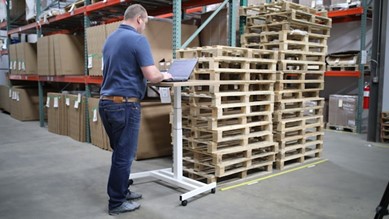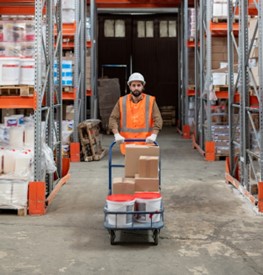John DiTonno of Philadelphia has worked as the Corporate Operations Manager at Premier Packaging, LLC for several years. In this role, John successfully oversaw transportation, storage, and operational activities involving 50 Third Party Logistics (3PL) providers and local customers. Most notably, John DiTonno conceptualized, established, and managed a 106,000 square foot manufacturing and storage facility in Fontana, CA for several years prior, overseeing a team of over 50 staff members. Through strategic planning and meticulous attention to detail, John DiTonno identified and eliminated bottlenecks and inefficiencies, driving substantial improvements in safety, quality, and productivity metrics. In the following article, John DiTonno of Philadelphia discusses the critical importance of warehouse safety and compliance, highlighting strategies to mitigate hazards, adhere to regulations, and foster a culture of employee well-being.
Warehouses are the central nervous system of modern commerce, acting as vital conduits in the intricate web of supply chains. Within these bustling hubs, goods flow ceaselessly, from arrival to storage and onward to distribution. Yet, amidst this flurry of activity and efficiency-driven operations, the imperative of safety is paramount.
Despite their pivotal role in the global economy, warehouses can be rife with potential hazards and risks to worker health and well-being. From the moment goods enter the facility to the time they are dispatched to their final destinations, ensuring the safety of the staff and the integrity of the goods themselves is a foundational responsibility. Therefore, in the fast-paced environment of warehouses, safety considerations must not only coexist with productivity, but also take precedence to safeguard the individuals who power the operation.
John DiTonno of Philadelphia Highlights the Importance of Warehouse Safety
John DiTonno explains that warehouses are dynamic environments where workers are exposed to various risks, including slips, trips, falls, and ergonomic injuries. Moreover, the presence of heavy machinery, high shelving, and hazardous materials amplifies these dangers. Prioritizing safety not only protects workers from harm but also enhances productivity, reduces absenteeism, and minimizes costly accidents.

Mitigating Common Hazards
Effective hazard identification and risk assessment are the cornerstones of warehouse safety. John DiTonno says that by conducting regular inspections and engaging employees in hazard reporting, warehouse managers can proactively identify and address potential risks. Common hazards such as improper storage, cluttered aisles, and inadequate lighting can be mitigated through measures like implementing clear signage, maintaining organized work areas, and installing adequate lighting fixtures.
Compliance with Regulations
Warehouses are subject to a comprehensive array of occupational health and safety regulations, mandated to uphold legal compliance and minimize liability risks. Among these regulations are the stringent standards set forth by OSHA (Occupational Safety and Health Administration) alongside industry-specific guidelines tailored to the warehouse environment.
To ensure adherence, these facilities must remain vigilant in staying abreast of evolving regulatory requirements and diligently implement robust safety protocols. John DiTonno of Philadelphia emphasizes the importance of various measures, including the provision of appropriate personal protective equipment (PPE), the conduct of regular safety training sessions to educate employees on hazard awareness and mitigation strategies, and the meticulous maintenance of accurate records documenting safety inspections and incident reports. These measures collectively form the cornerstone of a proactive approach to safety management, fostering a culture of vigilance and accountability within warehouse operations.

Promoting Employee Well-Being
John DiTonno highlights the holistic nature of employee well-being, noting that it extends beyond physical safety to encompass mental and emotional health considerations. In the warehouse setting, fostering a culture of well-being entails prioritizing ergonomics to minimize the risk of avoidable injuries and fatigue.
Additionally, these facilities can enhance employee support systems by providing access to counseling services and mental health resources, acknowledging the importance of addressing stress and emotional challenges in the workplace.
Moreover, promoting work-life balance through flexible scheduling arrangements and paid time off initiatives also contributes to overall employee wellness. Establishing open communication channels and encouraging feedback mechanisms empowers warehouse staff to voice concerns, share insights, and actively participate in continuous improvement efforts. By prioritizing both physical and psychological aspects of employee well-being, warehouse managers can cultivate a supportive work environment conducive to productivity, morale, and retention.
Implementing Safety Initiatives
Warehouse safety is a collaborative effort that requires buy-in from all levels of the organization. Implementing safety initiatives such as safety committees, toolbox talks, and incentive programs can encourage employee engagement and reinforce safety culture. Furthermore, investing in technology such as warehouse management systems (WMS) and automation can streamline processes and reduce the risk of human error.
Conclusion
John DiTonno of Philadelphia summarizes that prioritizing warehouse safety and compliance is not just a legal obligation but a moral imperative. By mitigating common hazards, adhering to regulations, and promoting employee well-being, facility managers can create safer, healthier, and more productive work environments. As the backbone of the supply chain, warehouses play a crucial role in ensuring the seamless flow of goods while safeguarding the health and livelihoods of the individuals who power them.









